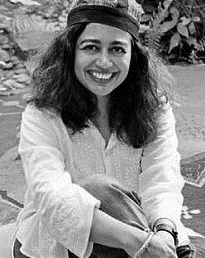One Globe Forum 2020
- New dates
coming soon! - Register
Ketna Patel

Ketna Patel, Indian Artist
Fondly nicknamed as Asia’s answer to American Pop Artist Andy Warhol, Ketna Patel is somewhat of a cultural chameleon. Born in Uganda and brought up in Kenya, East Africa, she left for London on her own at age 14. Surrendering ‘Swahili’ for ‘English’, she spent a decade grappling with a new world view education system before hurtling through two degrees in Design and Architecture. Unable to shake off the collisions and contradictions between her chaotic, third world diasporic gujarati – African background and the rather dry, intellectual British learning structures, she eventually traded her career in Architecture for an exploration into the unknown. That journey took her all over South East Asia for twenty years…..
Fast forward to today, and Ketna’s artworks are exhibited in museums, galleries and institutions all over the world. She is the recipient of the prestigious ASEAN Art Award, and hasachieved much critical acclaim for her thoughts and work which touch upon the often bewildering changes brought about by the compression of ‘Identity’ through Globalization. She is especially interested in engaging with the youth, and has deliberately chosen to work with young individuals that ‘don’t quite belong’, a phenomenon she is very familiar with! In Singapore, she has worked with The Ministry of Education and various International schools by holding workshops and talks. Last year, she was invited by the North London Collegiate in Jeju, South Korea, to hold a 2 week workshop on ‘creativity’ for sixteen year olds.
For most artists, the threshold between their life observations and their professional output is rather blurred. In Singapore, Ketna broke precedence by opening up her studio and home to the public. This was quite a different experience from quiet, intimidating galleries, which often feel ‘dead’. Her studio became a popular place for many schools, universities and institutions to hold brainstorming and creative explorative seminars and workshops. Over time, this unique place became a meeting place for many other artists, writers, musicians, poets, film makers, educators etc, and compelling new projects and relationships were borne thus. Classrooms full of school children alsobecame regular visitors…. the feedback she received was that it was important for them to be exposed to somewhat ‘unconventional lives’ where ‘work’ did not always mean putting on suits and commuting to cubicles in glass towers.
 Register for One Globe 2020
Register for One Globe 2020
SPONSOR
Showcase innovative products & services for the knowledge economy
Connect with decision makers and influencers and showcase your brand to a highly-targeted international audience. Contact our sales team for sponsorship opportunities that meet your specific requirements.
More details >>SPEAKER
Steer thought-leadership, voice opinions
Got an outstanding case study or a differentiated perspective on building a 21st century knowledge economy? Or incisive views, suggestions and proof points that can shape the future and inspire and impact millions? Send in your speaker recommendations.
More details >>DELEGATE
Learn, network, and discuss
Be part of an audience of leaders and stakeholders from across 20 countries to discuss, debate and deliberate issues at the intersection of economic development and growth through the lens of innovation, technology, education, skills, urbanization and policy on how to build a 21st century knowledge economy in India and South Asia. Book your seat today.
More details >>




